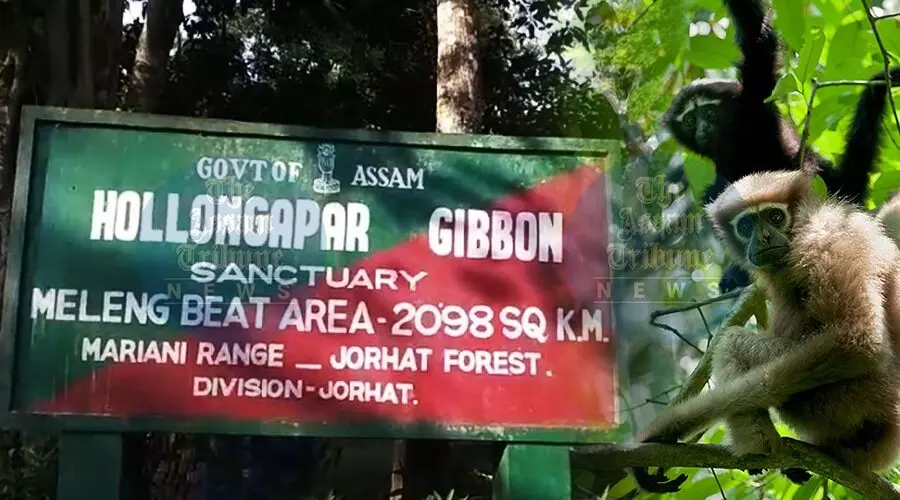Rail track electrification through Hollongapar Gibbon sanctuary sparks ecocide concerns
The sanctuary spread across an area of just 20.98 square km at Mariani in Jorhat district and shelters as many as eight species of primates—the highest in Assam—including the western hoolock gibbon. Hoolock gibbon, India's only ape, has a population of around 125 individuals in 26 groups in the sanctuary.

Guwahati, Nov 16: A trending image on social media of a capped langur walking on the exposed (not yet electrified) power lines of the railway track inside the Hollongapar Gibbon Wildlife Sanctuary has triggered dissenting voices from conservationists and nature lovers alike, calling for a halt to the track electrification project. "This is an open invitation to an ecocide," has been the common refrain of the conservation circles.
While the project has already been cleared by the National Board for Wildlife (NBWL) pending some mitigation measures to safeguard primates and other wildlife that regularly cross the track, conservationists and local stakeholders are sceptical about the 'safe guards' and assert that re-routing the short track outside the sanctuary offers the best solution to the problem. Even the Wildlife Institute of India (WII), while terming the un-electrified 1.65-km single track line as posing a grave danger to arboreal species like monkeys, had warned that any doubling of the railway line (a distinct possibility) would completely negate the prospects of artificial canopy bridge installation as a mitigation measure. "As is clear, the present un-electrified single-track 1.65-km-route railway line passing through the sanctuary has caused distress and posed significant conservation issues to arboreal animals. Hence, a future doubling of the line (if planned) will increase the canopy gap to a large extent and render any conservation interventions (such as ACB installations) futile," the WII had mentioned in its report, which was made before the track electrification.
The sanctuary spread across an area of just 20.98 square km at Mariani in Jorhat district and shelters as many as eight species of primates—the highest in Assam—including the western hoolock gibbon. Hoolock gibbon, India's only ape, has a population of around 125 individuals in 26 groups in the sanctuary.
Meanwhile, a section of environmentally conscious local residents has urged the NBWL to reconsider its decision to allow track electrification, reasoning that the single-track railway line, which has already claimed a sizeable number of diverse wildlife, including elephants, would trigger an ecocide if it is electrified.
"It is an open invitation to ecocide. As per the estimates of the Forest Department, annually 3-4 elephants have been crushed by speeding trains passing through the above-mentioned stretch. The existence of the railway line has affected the ecosystem of the entire forest area. The electrification with 25,000 volts will disrupt the existence of the already declining Hoolock Gibbon population," local stakeholders
Numal Chawra, Pinak Borthakur, Pinaki Sengupta, and Prarthana Bordoloi mentioned in their memorandum to the NWLB.
Moreover, the much-hyped canopy bridges, too, are no guarantee to provide safety to the gibbons and other arboreal species. This is corroborated by the fact that, as per the WII report, the lone artificial canopy bridge had never been utilised by any animal trying to cross the railway track.
"In 2015, the North East Frontier Railway authorities, along with the Assam State Forest Department, had built an artificial canopy bridge made of iron at one location across the railway track. However, despite their best intentions, the structure remains unused by arboreal mammals due to several of its design aspects not conforming to gibbons' specialised form of movement in the canopy (brachiation-swinging by arms/forelimbs)," the WII report noted.
The petitioners reasoned that as the mitigation strategies to contain the impact of the un-electrified railway track have not worked in protecting the wildlife, the electrification of the track is a sure recipe for disaster. "Since the railway stretch within HGS is relatively small, the Indian Railways must think long-term and demonstrate its conservation vision by exploring all possibilities to reroute the existing line outside HGS (and its ESZ) limits into the adjoining revenue and non-forest land. This will ensure that a balance between ecology and economy is struck and allow for the necessary doubling and electrification of such a rerouted line (with structural and other mitigation measures, if needed)," the WII report noted.
By-
Sivasish Thakur

